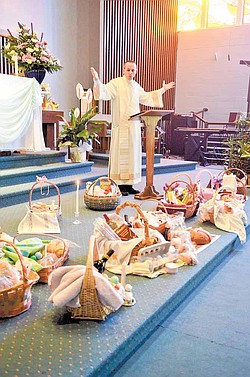Faithful flock to Valley church to have Easter baskets blessed
Blessing of the Baskets

Nick Moliterno, deacon at Immaculate Heart of Mary Church in Austintown, blesses parishioners' Easter baskets Saturday afternoon.
TRADITIONAL BASKET
The rules are relaxed for the modern Easter basket at the pre-feast blessing, but Slovak tradition calls for nine items to be in it. They are:
Eggs: Brightly decorated eggs are a symbol of new life in the risen Christ.
Pascha, or Easter bread: It’s sweet and rich in eggs and butter. It’s a symbol of Christ, Christians’ “true bread.”
Kielbasa: A spicy sausage that indicates God’s favor and generosity.
A piece of uncooked bacon, cured with spices: It symbolizes the abundance of God’s mercy.
Salt: It reminds people to flavor their dealings with others by Christ’s example.
Ham: It was popular with Czechoslovakians because of its richness, and it is symbolic of Easter’s great joy and abundance.
Cheese: A custard-style cheese, shaped into a ball and having a bland but sweet taste, indicates the moderation Christians should have in all things.
Horseradish and beets: They symbolize the suffering of Christ, who was put to death on a cross and rose from the dead three days later, defeating the sins of the world.
Butter: It’s shaped like a lamb, a small cross or placed in a glass dish. It reminds people to have Christ-like goodness toward all things.
Source: Nick Moliterno, deacon, Immaculate Heart of Mary Church, Austintown
By Jeanne Starmack
AUSTINTOWN
In the wicker baskets they brought to Immaculate Heart of Mary Church on Saturday afternoon, parishioners could put anything they wanted to be blessed for their Easter feast.
Deacon Nick Moliterno was getting ready for the 4 p.m. blessing as people were filing in and dropping baskets off in the front of the sanctuary.
“This is a celebration,” he explained as he placed a white, tapered candle near each of about 15 baskets — a blessing at 1 p.m. had drawn even more people.
“We’ve been fasting throughout Lent,” he said.
Now, on the eve of the most important day in Christianity, the day Jesus Christ rose from the dead and gave Christians eternal life, parishioners’ baskets represented the heavenly feast that awaits believers.
There were also items in the baskets that people had given up for Lent, the 40-day period of fasting and penitence from Ash Wednesday to Easter.
“And now, it’s the banquet that’s been waiting for us,” Moliterno said.
What was waiting for parishioners this year?
There were a lot of eggs, and Easter bread, kielbasa, bacon, salt, ham, cheese, horseradish, beets and butter — items dictated by the tradition that followed the Slovaks to America from the old country.
There also was a bag of Cheetos. Other baskets contained potato salad, cottage cheese and vegetables. Someone was going nontraditional with pasta and a jar of spaghetti sauce. And one little basket had only a bottle of cola, one colored egg, a small jar of jelly and two Hershey’s Kisses.
Erika Ohl was visiting from New Philadelphia, Ohio, for the weekend with her parents, Sharon and Bill Long. She brought her 6-month-old daughter, Karlynn, to continue the tradition she followed at the church while growing up.
“It’s a nice thing to do with family,” said Chrissy Bartelli, there with her husband, Angelo, and her mother, Carole Russ.
Russ said she’s been observing the tradition for at least 50 years — introduced to her by her husband, Robert, who followed it when he was a child.
Their basket included traditional items, but they didn’t forget Sydney, their English shepherd. Her treats and a bone were there as well.
Mary Yacavone and her mother, Mary Kohut, had traditional items in their basket, as did Marianne Hilderhoff — hers also included holy water.
During the ceremony, Moliterno lighted the candles at each basket.
“Give us new light, new life in Christ,” he said.
 43
43
